Author: 0xCousin, IOBC Capital
In the history of Wall Street, there has never been a shortage of legendary stories, but the strategic transformation of MicroStrategy Bitcoin Treasury Company is destined to become a unique new legend.
A Bitcoin Strategy That Captivated Global Attention
In 2020, the COVID-19 pandemic triggered a global liquidity crisis, prompting countries to adopt loose monetary policies to stimulate the economy, leading to currency devaluation and heightened inflation risks.
During the pandemic, Michael Saylor reassessed the value of Bitcoin. He believed that when the money supply grows at an annual rate of 15%, people need a hedge asset that is not tied to fiat cash flows. Therefore, he chose Bitcoin as the strategy for MicroStrategy.
Compared to BTC ETFs or other Spot Bitcoin ETPs launched by companies like BlackRock, MicroStrategy's Bitcoin strategy is more aggressive. It purchases Bitcoin using the company's idle funds, issuing convertible bonds, and increasing share issuance, allowing the company to gain potential profits from Bitcoin's rise while also bearing the potential risks of Bitcoin's decline, whereas ETFs/ETPs focus more on price tracking.
MicroStrategy's Funding Sources and Bitcoin Purchase Journey
MicroStrategy primarily raised funds to purchase Bitcoin through four avenues.
1. Using Own Funds for Purchases
In the initial three investments, MicroStrategy used its idle funds for purchases. In August 2020, MicroStrategy spent $250 million to buy 21,400 Bitcoins; in September, it invested $175 million to purchase 16,796 Bitcoins; and in December, it spent $50 million to acquire 2,574 Bitcoins.
2. Issuing Convertible Senior Notes
To purchase more Bitcoin, MicroStrategy began financing through the issuance of convertible bonds.
Convertible senior notes are a financial instrument that allows investors to convert the bonds into company stock under specific conditions. These bonds typically have lower interest rates, sometimes even zero, while setting a conversion price above the current stock price. Investors are willing to buy such bonds mainly because they provide downside protection (i.e., the principal and interest can be recovered at maturity) and potential gains when the stock price rises. The interest rates on several convertible bonds issued by MicroStrategy mostly range from 0% to 0.75%, indicating that investors are confident in the rise of MSTR's stock price, hoping to convert the bonds into stock for greater returns.
3. Issuing Senior Secured Notes
In addition to convertible senior notes, MicroStrategy also issued a $489 million senior secured note with a 6.125% interest rate maturing in 2028.
Senior secured notes are a type of secured bond with lower risk than convertible senior notes, but these bonds only offer fixed interest income. MicroStrategy has chosen to repay this batch of senior secured notes early.
4. At-the-Market Equity Offerings
As MicroStrategy's Bitcoin strategy began to show results, MSTR's stock price continued to rise, prompting MicroStrategy to adopt more at-the-market equity offerings for financing. This method of raising funds carries lower risk because it is not debt, has no repayment pressure, and does not have a foreseeable repayment date.
MicroStrategy has signed public market sales agreements with agents such as Jefferies, Cowen and Company LLC, and BTIG LLC. According to these agreements, MicroStrategy can periodically issue and sell Class A common stock through these agents. This is what the industry refers to as ATM.
At-the-market equity offerings are more flexible, allowing MicroStrategy to choose the timing of selling new shares based on secondary market conditions. Although issuing stock dilutes existing shareholders' equity, the correlation with Bitcoin prices and the increase in the amount of Bitcoin per share of MSTR lead to a complex market reaction, resulting in a higher overall volatility in MSTR's stock price.
The journey of MicroStrategy purchasing Bitcoin through the above four methods is as follows:
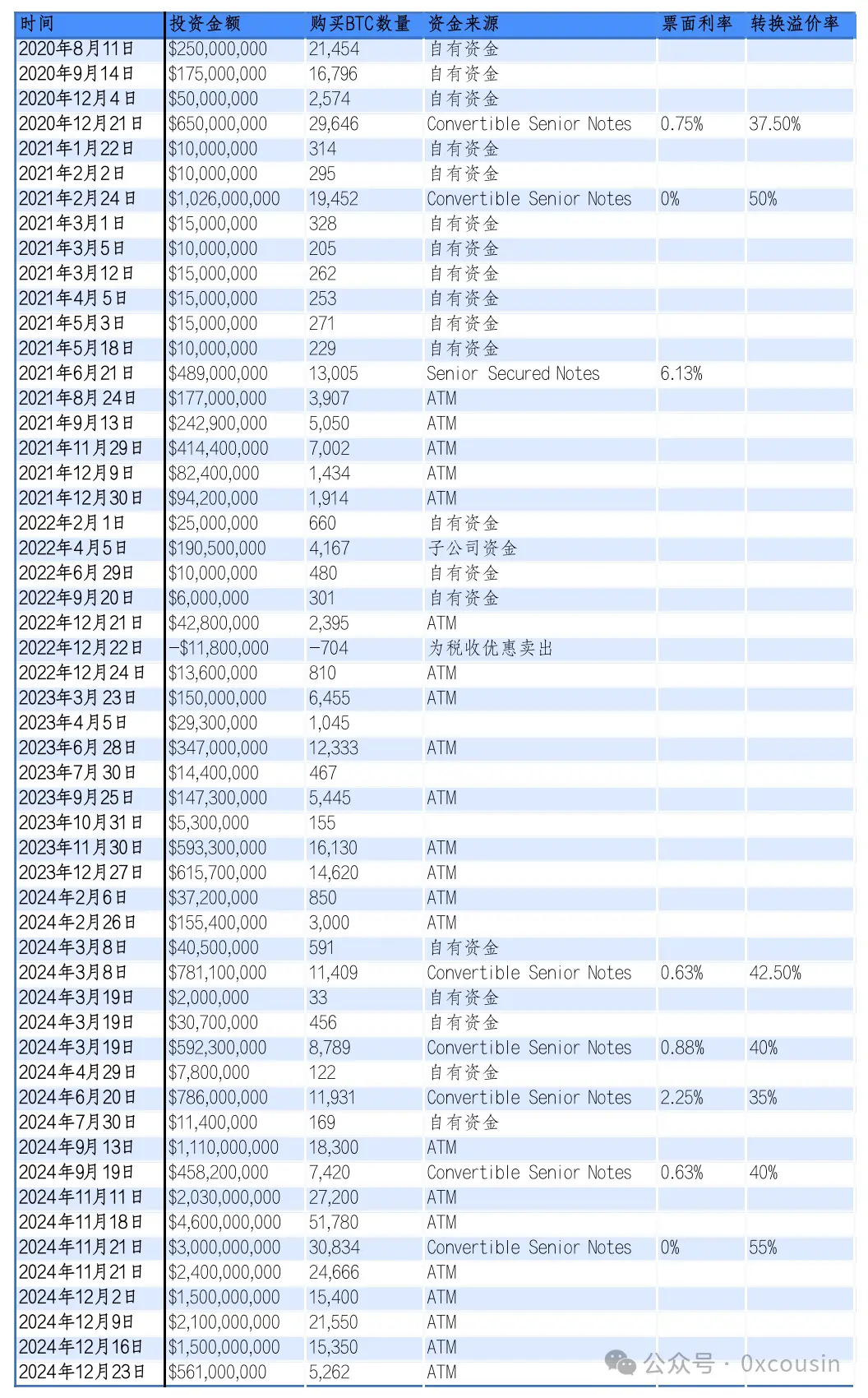
Produced by: IOBC Capital
Corresponding to the BTC price trend chart, MicroStrategy's specific purchase history is shown in the following image:
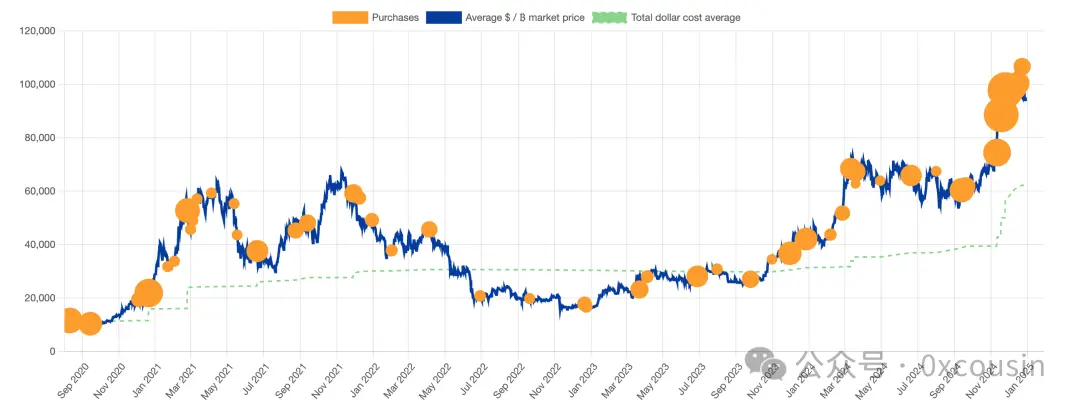
Source: bitcointreasuries.net
As of December 30, 2024, MicroStrategy has invested approximately $27.7 billion, purchasing 444,262 Bitcoins, with an average holding price of $62,257 per Bitcoin.
Key Questions Regarding MicroStrategy's "Intelligent Leverage" Bitcoin Purchases
There is considerable debate in the market regarding MicroStrategy's "Intelligent Leverage" strategy for purchasing Bitcoin. Here are my thoughts on several key questions that are hotly discussed in the market:
1. Is MSTR's Leverage Risk High?
To conclude, it is not very high.
According to information disclosed during MSTR's Q3 2024 earnings call, MSTR's total assets were approximately $8.344 billion, as the carrying value of Bitcoin in this report was only $6.85 billion (at that time, it held only 252,220 Bitcoins, calculated at a price of $27,160). Total debt was approximately $4.57 billion, resulting in a debt-to-equity ratio of 1.21.
We will not discuss the accounting standards but will consider the data at the time of actual sale, which reflects the latest market price. If we calculate using the latest market price of Bitcoin on September 30, 2024 ($63,560), the actual market value of the Bitcoins held by MSTR would be $16.03 billion, resulting in a debt-to-equity ratio of only 0.35.
Now, let's look at the data as of December 30, 2024.
As of December 30, 2024, MicroStrategy's total outstanding liabilities were $7.27385 billion, as detailed below:
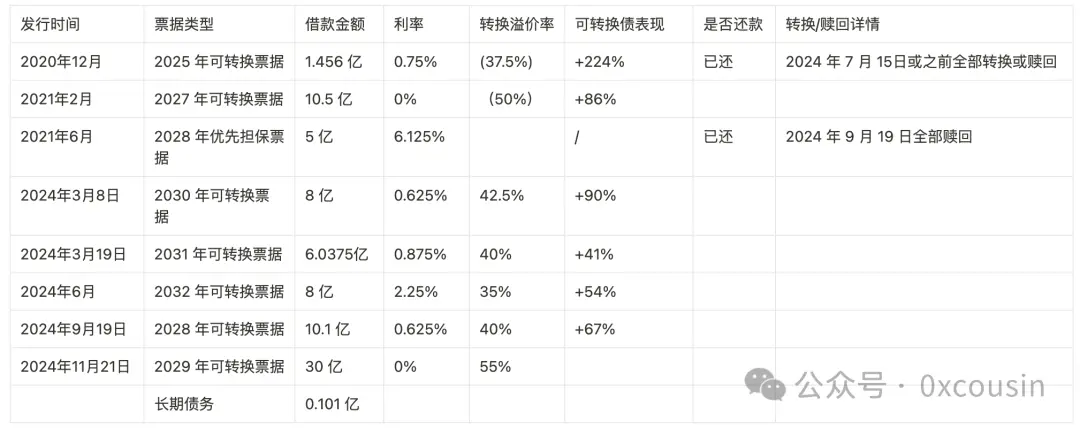
Produced by: IOBC Capital
As of December 30, 2024, MicroStrategy held 444,262 Bitcoins valued at $42.25 billion. If MicroStrategy's other assets remain unchanged (i.e., $1.49 billion), then MSTR's total assets would be $43.74 billion, with liabilities of $7.27385 billion, resulting in a debt-to-equity ratio of only 0.208.
Let's compare this with the debt-to-equity ratios of leading publicly listed companies in the U.S. — Alphabet 0.05, Twitter 0.7, Meta 0.1, The Goldman Sachs Group 2.5, JPMorgan Chase & Co. 1.5.
MicroStrategy is a company transitioning from the software industry to the financial industry, and this debt-to-equity ratio is still healthy.
2. Under What Circumstances Could These Convertible Bonds Become an Unbearable Burden in the Future?
To conclude, if MicroStrategy does not continue to issue convertible bonds in the future, then Bitcoin would need to fall below $16,364 for the value of the 444,262 Bitcoins held by MicroStrategy to be less than the total amount of its convertible bonds of $7.27 billion. If MicroStrategy only uses ATM financing and idle funds to buy Bitcoin in the future, as the number of Bitcoins held by MicroStrategy increases, this "insolvency" price line could become even lower.
If MicroStrategy continues to issue convertible bonds to purchase Bitcoin at high prices and Bitcoin enters a bear market, a decline in Bitcoin prices could lead to the value of the Bitcoins held by MicroStrategy falling below the total amount of its convertible bonds, which would also cause MSTR's stock price to languish, thereby affecting its refinancing ability and debt repayment capacity, ultimately making the convertible bonds an unbearable burden.
MicroStrategy's convertible bonds allow bondholders the right to convert their bonds into MSTR stock, divided into two phases: First, the initial phase — if the trading price of the bonds drops by more than 2%, creditors can exercise their rights to convert the bonds into MSTR shares and sell them to recover their investment; if the trading price of the bonds remains stable or even rises, creditors can sell the bonds in the secondary market to recover their investment. Second, the later phase — when the bonds are nearing maturity, the 2% rule no longer applies, and bondholders can either take cash and walk away or directly convert the bonds into MSTR stock.
Since the convertible bonds issued by MicroStrategy are low-interest or even zero-interest bonds, it is clear that what creditors want is actually the conversion premium. If, at the repayment date, MSTR's stock price has increased compared to the price at the time of financing, creditors are more likely to consider converting to stock. If MSTR's stock price has decreased compared to the price at the time of financing, creditors will consider wanting the principal and interest.
If creditors do not choose to convert to MSTR stock and repayment to creditors is indeed required, MicroStrategy has several options:
Continue issuing new shares to raise funds for repayment;
Continue issuing new debt to repay old debt; (This has already been done in September 2024)
Sell some Bitcoins to make repayments.
Therefore, at present, the likelihood of MicroStrategy falling into an "insolvency" situation is low.
3. Why Are Investors Starting to Care About MSTR's Bitcoin Per Share?
To conclude, the Bitcoin per share will determine MSTR's net asset value per share.
Whether issuing convertible bonds or using ATM, both are financing methods that dilute equity. The purpose of financing is to increase Bitcoin reserves. For MSTR's shareholders, equity dilution is a negative factor, traditionally seen as not a good thing. The management of MicroStrategy tells MSTR shareholders the story of — BTC Yield KPI.
Essentially, it states that as long as MSTR's market value is higher than the total value of the held BTC, there is a market value premium, and therefore diluting MSTR's equity to buy BTC can enhance the Bitcoin per share of MSTR. An increase in MSTR's Bitcoin per share means that MSTR's net asset value per share is growing, making it worthwhile for shareholders to dilute equity to finance Bitcoin purchases.
Currently, MicroStrategy holds 444,262 BTC, with a total holding value of approximately $42.256 billion. With the current market capitalization of MSTR at $80.37 billion, MSTR's market value is 1.902 times the value of its Bitcoin holdings, indicating a current premium rate of 90.2%. The total share capital of MSTR is 244 million shares, with each share corresponding to approximately 0.0018 BTC.
This is the essence of the so-called "intelligent leverage," transforming the difference between the company's market value and the value of its Bitcoin holdings into a capital operation advantage.
Four: Why Has MicroStrategy Been More Aggressive in Buying Bitcoin in the Last Two Months?
To conclude, it may be because MSTR's stock price is very high.
MicroStrategy has significantly increased the scale of its financing to buy Bitcoin in the last two months. In November and December 2024, MicroStrategy invested a total of $17.69 billion through ATM and issuing convertible bonds (accounting for 63.8% of the total investment), purchasing 192,042 Bitcoins (accounting for 43.2% of the total purchases). Of this, only $3 billion was from convertible bonds, while the remaining $14.69 billion was financed through ATM.
Overall, the entire process of MicroStrategy's strategic allocation of Bitcoin has characteristics of dollar-cost averaging over time; however, in terms of quantity and amount, it seems to be more aggressive in buying during a bull market than in a bear market.
I cannot fully understand this characteristic and can only boldly speculate that it may be because MSTR's stock price increases more during a bull market. In August 2024, after a stock split, MSTR's stock price tripled, and for the year, the stock price increased more than fourfold, while Bitcoin's increase this year was only 2.2 times.
MicroStrategy's CEO mentioned a beautiful "42B plan" during the Q3 2024 earnings call.
British author Douglas Adams mentioned in "The Hitchhiker's Guide to the Galaxy" that the supercomputer "Deep Thought" provided the answer to "life, the universe, and everything" as 42.
MicroStrategy believes this is a magical number, thus proposing the 42B financing plan. The number 21 is also magical, as the maximum total supply of Bitcoin is 21 million. Therefore, MicroStrategy plans to issue $21 billion in ATM + $21 billion in fixed income over the next three years to continue increasing its Bitcoin holdings.
Assuming MicroStrategy ultimately raises $42 billion through share issuance, and assuming the share price is $330 for the issuance, the total share capital will become 371.3 million shares. If MicroStrategy buys Bitcoin at an average price of $100,000, the company could acquire 420,000 Bitcoins, bringing MicroStrategy's total holdings to 864,262 Bitcoins. At that time, the Bitcoin per share would increase to 0.00233, representing a growth of approximately 29.4%. At this point, MSTR's total market capitalization would be $122.53 billion, with the total value of the held BTC at $86.4 billion. In this scenario, the market value premium would still exist.
Five: What Other Catalysts Are There for Bitcoin's Price Increase After MicroStrategy?
To conclude, besides the publicly traded companies that are driven by MicroStrategy to buy Bitcoin, the only other thought is more national strategic reserves, but I do not hold high expectations for this bull market.
The recent cycle of Bitcoin's price increase is mainly driven by the following major buyers:
1. Long Term Holders with Strong Consensus on Bitcoin
The long-term rise of Bitcoin does not require justification; it is as natural to BTC enthusiasts as monkeys climbing trees and mice digging holes, because it is digital gold.
After Bitcoin fell below $16,000, the most mainstream Antminer S17 series mining machines were at shutdown prices. Other mining machines like the Shenua M30S, Hippo H2, and Antminer T19 had also fallen into the shutdown price range. This price range would see a rebound even if nothing happened. The transition from bull to bear is like a basketball freely falling from a height; after hitting the ground, it will bounce back multiple times with decreasing intensity.
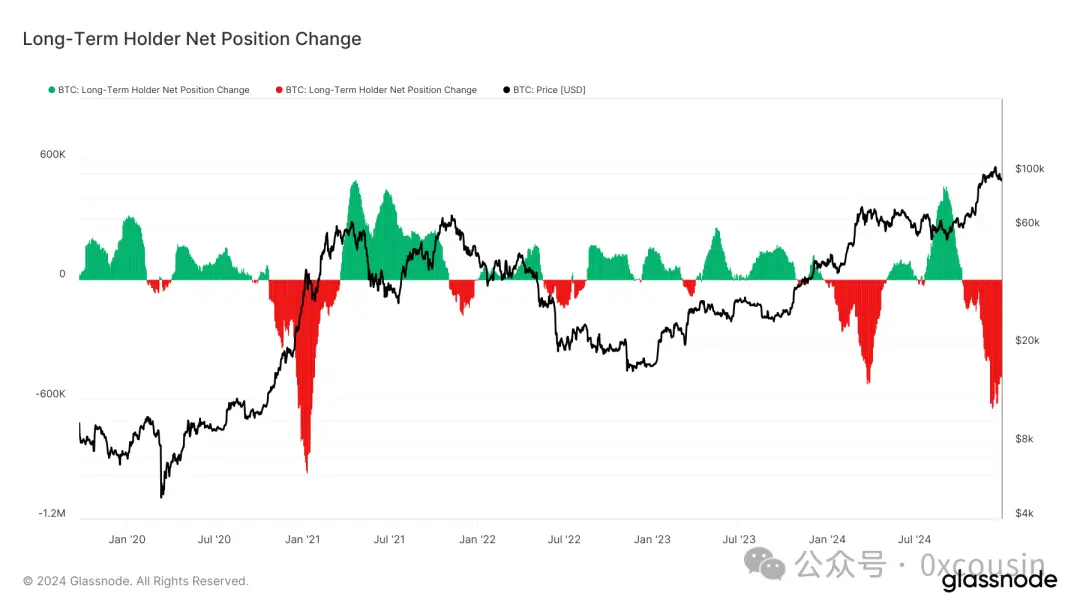
Source: glassnode
As seen in the above chart, Long Term Holders have been continuously increasing their positions since the end of 2022.
After more than a decade of development, the consensus around Bitcoin has become strong enough, with on-site investors and Long Term Holders sharing a consensus around the shutdown prices of mainstream mining machines.
2. ETFs Bringing Incremental Funds from Traditional Financial Markets
Since the approval of BTC ETFs, a total of 528,600 BTC has flowed in, bringing nearly $36 billion in incremental buying power to Bitcoin during this bull market, and $2.6 billion to ETH.
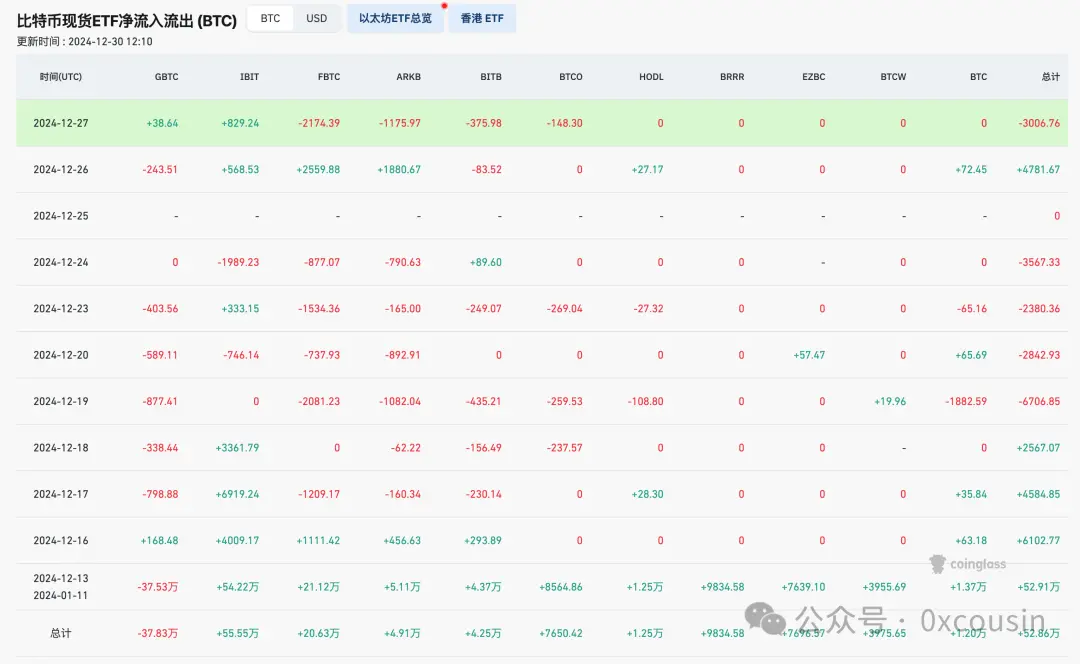
Source: coinglass.com
Additionally, the approval of BTC ETFs (and ETH ETFs) will create a ripple effect, leading more traditional financial institutions to pay attention to and invest in the crypto space.
3. MicroStrategy's Continued Purchases, Imitated by Several Public Companies, Davis Double-Click
According to data from Bitcointreasuries, as of December 30, 2024, there are 149 entities holding a total of over 2.95 million Bitcoins. Moreover, this data has been rapidly increasing recently.
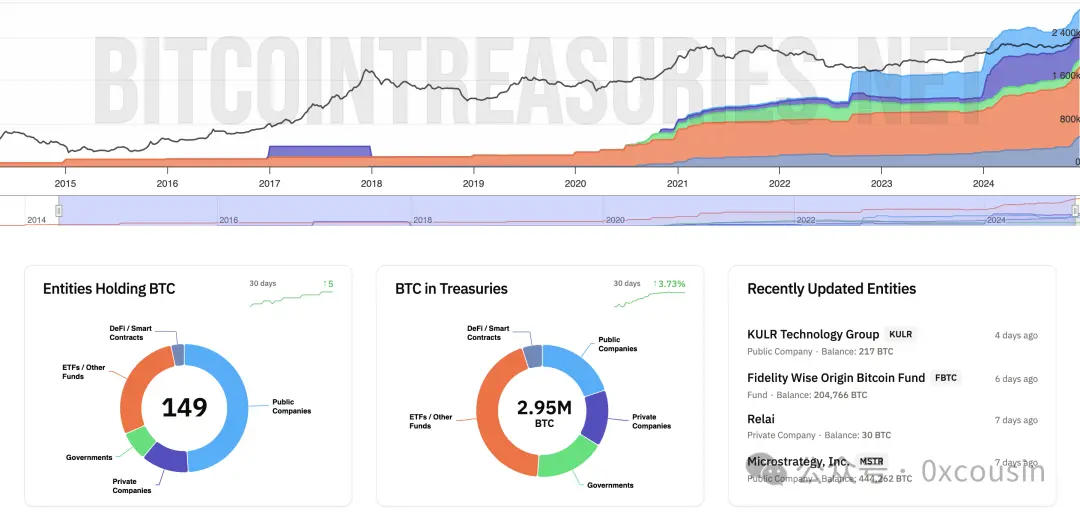
Source: bitcointreasuries.net
Among these entities holding Bitcoin, 73 are publicly traded companies, 18 are private companies, 11 are countries, and 42 are ETFs or funds, along with 5 DeFi protocols.
MicroStrategy is the first publicly traded company to adopt the "Bitcoin Treasury Company" strategy, but it is not the only one. Companies like Marathon Digital Holdings, Riot Platforms, and Boyaa Interactive International Limited have also implemented this strategy, but MicroStrategy's influence remains the largest.
4. National Strategic Reserves
Some governments currently hold Bitcoin. The specific details are shown in the following image:

Source: bitcointreasuries.net
Although these countries hold Bitcoin, most of it was seized by law enforcement during enforcement actions. They have not sold it temporarily, so they do not qualify as stable holders.
Among these countries, only El Salvador is likely a true BTC holder. Since 2021, El Salvador has been buying Bitcoin, purchasing 1 Bitcoin daily, and currently holds 6,002 BTC, valued at over $560 million.
Additionally, Bhutan holds 11,688 BTC through Bitcoin mining. However, Bhutan does not qualify as a BTC holder, as it has reduced its holdings in the last two months.
During his campaign, U.S. President Trump stated that if elected, he would establish a Bitcoin strategic reserve.
If there is anything that could further drive Bitcoin's price increase after MicroStrategy, it would be Trump's administration promoting a Bitcoin strategic reserve for the U.S. government, which could lead to more countries establishing strategic reserves of Bitcoin.
Conclusion
MicroStrategy's Bitcoin strategy is not just a corporate transformation experiment; it is also a significant innovation in financial history. Through sophisticated capital operations, intelligent leverage, and profound insights into Bitcoin's value, it has not only achieved remarkable growth in its market value but has also brought Bitcoin more deeply into the view of traditional finance, breaking down the barriers between crypto assets and mainstream capital markets.
MicroStrategy's bold attempt may just be the prelude to the Bitcoin legend, a small step in the true rise of Bitcoin, yet potentially a giant leap in the new financial era.
免责声明:本文章仅代表作者个人观点,不代表本平台的立场和观点。本文章仅供信息分享,不构成对任何人的任何投资建议。用户与作者之间的任何争议,与本平台无关。如网页中刊载的文章或图片涉及侵权,请提供相关的权利证明和身份证明发送邮件到support@aicoin.com,本平台相关工作人员将会进行核查。




